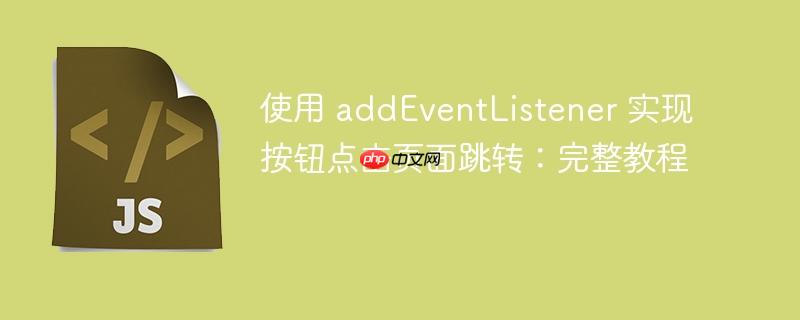
在现代 web 应用中,用户与页面元素的交互是核心。按钮点击触发的页面跳转是一种非常常见的交互模式,例如提交表单后跳转到结果页,或点击导航菜单跳转到其他模块。javascript 提供了多种方式来监听这些交互并执行相应的操作,其中 addeventlistener 是最常用且推荐的方法之一。
addEventListener() 方法用于将事件处理程序附加到指定的元素。它允许你在不覆盖现有事件处理程序的情况下,为同一元素和同一事件类型添加多个事件处理程序。
其基本语法如下:
element.addEventListener(event, function, useCapture);
在本教程中,我们将主要关注 click 事件,即用户点击元素时触发的事件。
在 JavaScript 中,可以通过 window.location 对象来控制浏览器的地址栏,从而实现页面跳转。window.location 对象包含当前 URL 的信息,并提供了修改 URL 的方法。
主要有两种常用的跳转方法:
window.location.replace() 方法会用新的 URL 替换当前页面的 URL,并且不会在浏览器历史记录中留下当前页面的记录。这意味着用户无法通过浏览器的“后退”按钮返回到原页面。
适用场景:
代码示例:
// 当点击事件触发时,跳转到指定URL,并替换历史记录
window.location.replace('https://www.example.com/target-page.html');直接修改 window.location.href 属性会使浏览器加载新的 URL,并且会将当前页面添加到浏览器的历史记录中。用户可以通过“后退”按钮返回到原页面。
适用场景:
代码示例:
// 当点击事件触发时,跳转到指定URL,并保留历史记录 window.location.href = 'https://www.example.com/another-page.html';
两者区别总结:
| 特性 | window.location.replace(URL) | window.location.href = URL |
|---|---|---|
| 历史记录 | 不会保留当前页面 | 会保留当前页面 |
| 后退按钮 | 无法返回到原页面 | 可以返回到原页面 |
| 行为 | 替换当前历史条目 | 添加新的历史条目 |
下面我们将结合 HTML 和 JavaScript,演示如何通过按钮点击实现页面跳转。
首先,我们需要一个按钮元素来触发跳转。给按钮一个易于识别的 ID 是个好习惯,方便在 JavaScript 中准确获取到它。
<!-- index.html -->
<!DOCTYPE html>
<html lang="zh-CN">
<head>
<meta charset="UTF-8">
<meta name="viewport" content="width=device-width, initial-scale=1.0">
<title>按钮点击跳转示例</title>
</head>
<body>
<h1>点击下方按钮跳转页面</h1>
<button id="redirectButton">点击我跳转到示例页面</button>
</body>
</html>接下来,在 JavaScript 中获取到这个按钮元素,并为其添加 click 事件监听器。在事件处理函数中,我们使用 window.location.replace() 或 window.location.href 来实现页面跳转。
// script.js (或直接嵌入到HTML的<script>标签中)
// 1. 获取按钮元素
// 使用 document.querySelector 或 document.getElementById
let btn = document.getElementById('redirectButton');
// 2. 为按钮添加点击事件监听器
btn.addEventListener('click', () => {
// 3. 在事件处理函数中执行页面跳转逻辑
// 示例一:使用 window.location.replace() 进行跳转(不保留历史记录)
// 请将 'https://www.example.com' 替换为你实际的目标URL
window.location.replace('https://www.example.com');
// 示例二:使用 window.location.href 进行跳转(保留历史记录)
// window.location.href = 'https://www.another-example.com';
});为了方便测试,你可以将 HTML 和 JavaScript 代码放在同一个文件中:
<!DOCTYPE html>
<html lang="zh-CN">
<head>
<meta charset="UTF-8">
<meta name="viewport" content="width=device-width, initial-scale=1.0">
<title>按钮点击页面跳转示例</title>
<style>
body {
font-family: Arial, sans-serif;
display: flex;
flex-direction: column;
align-items: center;
justify-content: center;
min-height: 100vh;
margin: 0;
background-color: #f4f4f4;
}
h1 {
color: #333;
margin-bottom: 20px;
}
button {
padding: 12px 25px;
font-size: 18px;
color: white;
background-color: #007bff;
border: none;
border-radius: 5px;
cursor: pointer;
transition: background-color 0.3s ease;
}
button:hover {
background-color: #0056b3;
}
</style>
</head>
<body>
<h1>点击下方按钮跳转页面</h1>
<button id="redirectButton">点击我跳转到示例页面</button>
<script>
// 获取按钮元素
let redirectButton = document.getElementById('redirectButton');
// 为按钮添加点击事件监听器
redirectButton.addEventListener('click', () => {
// 请将 'https://www.example.com' 替换为你实际的目标URL
// 推荐使用 window.location.replace() 如果你不希望用户通过后退按钮返回
window.location.replace('https://www.example.com');
// 如果希望用户能够通过后退按钮返回,可以使用 window.location.href
// window.location.href = 'https://www.another-example.com';
});
</script>
</body>
</html>通过 addEventListener 监听按钮的 click 事件,并结合 window.location.replace() 或 window.location.href,我们可以灵活地控制页面跳转行为。理解这两种跳转方式的区别,能够帮助开发者根据具体的业务需求,选择最合适的跳转策略,从而提升用户体验和应用的功能性。掌握这些基础知识是构建响应式和交互式 Web 应用的关键一步。
以上就是使用 addEventListener 实现按钮点击页面跳转:完整教程的详细内容,更多请关注php中文网其它相关文章!

每个人都需要一台速度更快、更稳定的 PC。随着时间的推移,垃圾文件、旧注册表数据和不必要的后台进程会占用资源并降低性能。幸运的是,许多工具可以让 Windows 保持平稳运行。




Copyright 2014-2025 https://www.php.cn/ All Rights Reserved | php.cn | 湘ICP备2023035733号